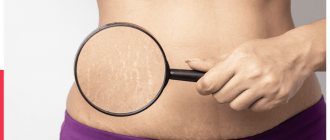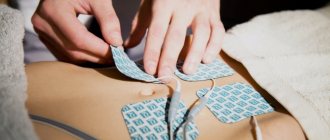Types of stretch marks
Stretch marks - a special type of atrophic scars - can be located both vertically and horizontally. The location of stretch marks indicates the cause of their occurrence:
- horizontal ones appear due to hormonal imbalances;
- vertical – due to pregnancy or rapid weight gain
Old stretch marks are more difficult to correct, so the sooner you start taking measures to eliminate them, the more pronounced the result will be. Don’t let the formation of stretch marks take its course: even though they fade over time, they cannot disappear completely without additional cosmetic care. Stages of striae formation:
- the first stage - a purple or reddish “vein” appears at the site of skin stretching;
- the second stage (atrophic) is the replacement of connective tissue. Scar formation, thinning of the dermis and epidermis. It is expressed by lightening stretch marks at the site of skin breaks.
Causes of stretch marks
Stretch marks (striae) are the result of skin stretching during pregnancy. This happens due to the rapid increase in a woman’s body weight. Numerous tears occur in the skin and subcutaneous fat, which externally appear as burgundy scars. During pregnancy, a woman’s body quickly increases in size, and numerous tears occur in the layers of skin and subcutaneous tissue. They fill with connective tissue and form scars. Stretch marks can appear in different places:
- on the stomach;
- on the sides;
- on the hips;
- on the buttocks;
- on the chest
Mesotherapy for stretch marks
Not only ozone gas, but also other substances can be injected under the skin. Intradermal microinjections of biologically active drugs, which allow you to reconstruct the structure of the skin from the inside, improve blood circulation and help in the fight against stretch marks - this is mesotherapy.
The composition of “cocktails” of drugs, which may include vitamins, antioxidants, microelements, amino acids, enzymes, is kept secret by each medical center from its competitors. There is no one universal formula. However, the essence of all injections is to nourish the skin from the inside, stimulate metabolic processes at the cellular level and solve visible cosmetic problems. \
A nice bonus: mesotherapy is an effective technique in the fight against stretch marks, in the fight against cellulite, and in the fight against excess weight. So the procedure will allow you to solve several problems at once. And, by the way, it is quite possible to endure this procedure without anesthesia.
The main causes of stretch marks
- Sudden weight gain or rapid growth of the abdomen in a pregnant woman.
- Genetic predisposition. Stretch marks are mostly genetic. If your mother/grandmother/sister/aunt had stretch marks, then the likelihood that you will develop them increases rapidly.
- Hormonal changes. During pregnancy, cortisol production increases. This hormone softens the joints of the pubic bones to make it easier for the baby to pass through the birth canal. At the same time, cortisol reduces the production of collagen and elastin, causing the skin to become less elastic.
Belly after childbirth: how to return to its previous shape?
Of course, there is no need to worry about the fact that the belly after childbirth is still far from the desired shape. After all, time must pass for the muscles, uterus, and skin to contract, for the internal organs to return to their original position and for the waist to begin to please the young mother.
Stretch marks after childbirth
Stretch marks after childbirth (striae) are scar changes that occur due to tears in the skin. Stretch marks after childbirth appear in the form of stripes of different colors - from white to purple-purple. Over time, stretch marks after childbirth become lighter, but never completely disappear on their own. Red or purple stretch marks after childbirth occur because the resulting connective tissue at the site of the tear (scar tissue) is riddled with blood vessels; Over time, the vessels become empty and the stretch marks turn white. Scar tissue does not contain pigment and such defects are clearly visible, especially after sunbathing. Stretch marks themselves are not dangerous, but they can look very unattractive.
Where there are stretch marks on the skin, its condition is close to 60 years of age, that is, the mechanisms of collagen and elastin formation have completely faded away.
What to do?
Unfortunately, currently in world medical practice there is no method for completely eliminating scar tissue (which is what stretch marks after childbirth are). It is better to start treatment of stretch marks using various professional cosmetic techniques after childbirth, in the autumn-winter period, in order to achieve the desired result by summer.
The course of treatment for stretch marks after childbirth may include the following techniques: manual or vacuum massage (can be performed as early as 6 weeks after childbirth), mesotherapy (used no earlier than 3 weeks after completion of breastfeeding or 6 months after childbirth), peelings ( chemical peeling is recommended after breastfeeding) and microdermasia (the procedure is also allowed for nursing mothers). Various types of wraps (mud, clay, algae) are contraindicated for pregnant and nursing mothers, as well as vacuum, microcurrent and endermological procedures - for example, myostimulation. The number and frequency of alternating treatment sessions is prescribed by a cosmetologist, taking into account the initial condition of the skin. Sunbathing during this period is not recommended.
The most effective treatment today is laser treatment for stretch marks (laser resurfacing). However, this is a very serious procedure that requires a hospital stay, and recovery from it will not be quick. If you still decide to have it, then this can be done no earlier than 6 months after birth.
And finally, the most radical method of treating stretch marks is abdominoplasty - surgical removal of skin defects. Such intervention is permitted no earlier than 3 weeks after the end of lactation or 6 months after childbirth.
Why do stretch marks appear after childbirth?
Most often, stretch marks after childbirth appear during a period of powerful hormonal changes in the body - during puberty, taking certain hormonal drugs, with disorders in the endocrine system and rapid weight gain and/or fluctuations, including during pregnancy. In addition, while waiting for a baby, the formation of the hormone cortisol increases, which provokes ruptures of elastin fibers in places of greatest stretch: on the hips, buttocks, abdomen and chest.
Other factors also influence the appearance of stretch marks: overstretching of the skin, when elastin fibers simply do not have time to form behind its rapidly increasing surface; loss of moisture from the skin - overdried skin “breaks” and the fracture site is filled with collagen fibers that are not capable of stretching; deficiency in food of components necessary for the synthesis of elastin fibers - protein, calcium, iron, vitamins B, C, A, etc.). Recent research data have shown that heredity does not play such a decisive role in the formation of stretch marks as was previously attributed to it. That is, if the mother had stretch marks, this does not mean that the daughter will also have them. However, genetic predisposition should not be completely dismissed. If stretch marks did not appear during the first pregnancy, this does not guarantee their absence during the next one.
Is it possible to get rid of stretch marks after childbirth?
Of course, it is possible in some cases to prevent the appearance of stretch marks after childbirth or to reduce their number, but no one can guarantee that they will not occur at all. In any case, it is better to take care of your skin in a timely manner to minimize the possibility of stretch marks. Massaging problem areas and applying special anti-stretch marks to them will help. It is important to eat protein foods (fish and meat), since protein is the basis of collagen and elastin fibers. Drink enough liquid: this will ensure good turgor, improve metabolic processes and accelerate the removal of metabolic products from the skin and subcutaneous tissue. In order to prevent the appearance of stretch marks, a contrast shower will come to the rescue. Alternating cool and warm water increases the intensity of blood flow and metabolic processes in the skin and subcutaneous tissue, thereby increasing the formation of elastin and collagen fibers.
Diastasis after childbirth
Diastasis after childbirth is the divergence of the rectus abdominis muscles (right and left) relative to the midline of the abdomen. This occurs in response to the fact that the enlarged uterus during pregnancy puts pressure on the anterior abdominal wall and the muscles gradually move apart to the sides; in addition, this is facilitated by the pliability (“softening”) of the connective tissue and ligamentous apparatus under the influence of the hormonal background of the expectant mother. In addition, there is a genetic predisposition to the development of diastasis after childbirth: expectant mothers of short stature and thin build, as well as those who did not exercise before and during pregnancy, are more susceptible to this process. However, slight widening of the midline occurs during pregnancy in almost all women, and this is normal.
What to do?
If you are lying on your back and 2–2.5 fingers pass between the abdominal muscles (along the midline) (that is, the width of the diastasis is about 2 cm), the problem is serious and you should consult a specialist (surgeon and gynecologist), since with significantly pronounced diastasis Surgical repair of the abdominal wall may be required. In addition to the imperfect appearance of the tummy, diastasis after childbirth reduces the integrity and functional strength of the abdominal wall (that is, hernias may appear), and can also cause lower back pain and a number of gynecological problems.
If diastasis after childbirth is no more than 2 cm, physical exercise after childbirth will help get rid of it. You can start exercising approximately 1–1.5 months after the baby is born. It should be said right away that there are exercises that are undesirable to do with diastasis: they are aimed mainly at strengthening the upper abdominal muscles (exercises that involve lying on your back on a fitball; abdominal exercises that involve lifting the upper back from the floor against gravity, etc.). P.); lifting or carrying heavy objects (including a child); Most exercises are on all fours. Thus, the upper abdominal muscles are strengthened, but the lower ones remain flabby and muscle separation (diastasis) becomes even more noticeable.
The main emphasis in exercises should be on strengthening the lower abdominal muscles. It is advisable to exercise 3 times a week and the results will not take long to arrive.
Abdominal enlargement after childbirth
During pregnancy, the enlarged uterus and baby make up the bulk of the abdomen, the rest of the volume is internal organs and subcutaneous fat. And immediately after the birth of the baby, the stomach, of course, does not become flat, but still protrudes significantly. The uterus contracts, but it returns to its previous size gradually: immediately after childbirth, the size of the uterus corresponds to 16 weeks of pregnancy. Thus, a belly after childbirth is completely normal. Over the next week, due to the reverse development of the uterus, its weight decreases to 500 g, by the end of the 2nd week - to 350 g, the 3rd - to 250 g, and only 5-6 weeks after birth it will weigh only 50 g , that is, it acquires its “pre-pregnancy” state.
In order for the uterus to contract as quickly as possible, it is necessary to feed the baby on demand, since at the same time the mother’s brain produces the optimal amount of oxytocin, a hormone that promotes contraction of the muscles of the uterus. In addition, it is also recommended to apply ice on the stomach for 7-10 minutes 4-5 times a day (while still in the maternity hospital), especially after each urination and to lie on the stomach more often. Thus, it takes a significant amount of time for the abdominal muscles to contract after childbirth, so it is only after 6–8 weeks that they return to their previous shape and the tummy can become smaller.
Subcutaneous fat in the abdominal area can also increase significantly during pregnancy (it protects the baby from external influences), which is facilitated by hormonal changes occurring in the body of the expectant mother and poor nutrition. Therefore, the condition of the subcutaneous fat tissue after childbirth, and therefore the tummy, largely depends on how many extra pounds the woman has gained during pregnancy. After a cesarean section, there is a postoperative suture, the abdominal muscles recover somewhat more slowly, and physical exercises after childbirth can be performed by a young mother no earlier than 1.5–2 months. But this does not mean that the belly after childbirth will not shrink to its previous size, it will just happen a little later and subject to all the doctors’ recommendations.
What to do?
To reduce belly fat after childbirth, exercise and a balanced diet can mainly help. When can you start practicing? There is no clear opinion here. Some experts believe that a young mother can begin training her abdominal muscles as soon as she feels good. If there was no caesarean section, then you can start exercising almost immediately after giving birth (some exercises can be done without even getting out of bed). Others still recommend waiting until 6 weeks with training and a subsequent examination by a gynecologist, especially if there were complications in the postpartum period or a cesarean section (then you will have to wait until the suture heals, which is at least 1.5–2 months).
It all depends on how regularly the young mother exercised before pregnancy and while carrying the baby. If she devoted enough time to sports before giving birth, then most likely she can continue these workouts almost immediately, or at least do light exercises.
Walking is very useful for faster recovery of physical fitness, so it is advisable to take regular walks with your baby whenever possible. It is not recommended to perform exercises with jumping, running, squats, or lifting weights, as this can increase pressure in the pelvic floor and provoke involuntary urination, as well as contribute to the tension of the sutures. If sports activities were interrupted during pregnancy or the mother decided to start exercising for the first time in order to get in shape after childbirth, then you should start very gradually. Swimming tones the skin well, shapes the muscles and reduces fat deposits. But there are limitations here: it is not recommended to swim in the pool during the first 6 weeks after birth to avoid gynecological infections.
If a mother is breastfeeding, then you should not do exercises that cause discomfort in the chest. It is better to exercise after feeding: this way there will be no unpleasant feeling of breast fullness, besides, after vigorous exercise, the baby may completely abandon the breast or suckle less actively, since during exercise, metabolic products enter the milk, which can give it an unpleasant taste (an hour after training everything should go back to normal).
Excessive physical activity after childbirth in the first weeks can lead to increased vaginal discharge or bleeding. This is a sign that you need to reduce your load and consult a doctor. During exercise, you must wear a special sports support bra.
Many women who dream of losing weight quickly begin to limit themselves in food. But a mother who is breastfeeding her baby should not do this, of course; it is better to wait until the end of lactation. Firstly, it will be a wasted effort, and secondly, you can harm both your health and the health of the baby. In addition, after dietary restrictions and weight loss, it is easy to gain extra pounds again, and this will not improve the condition of the skin and muscles; on the contrary, it can provoke the appearance of new stretch marks.
You need to eat fractionally: 5-6 times a day, observing the amount of calories consumed (for nursing mothers - 2500-3000 kcal per day, for non-breastfeeding mothers - it is better to calculate calories using special formulas, taking into account age and physical activity). It should be said that if there is a problem of excess weight, then it should be reduced gradually. If body weight decreases by 250–400 g per week, then this is a good result and you should not rush, since faster weight loss is fraught with the appearance of saggy skin and stretch marks (elastin fibers should gradually shrink, adapting to the decrease in skin size).
It is advisable to use moisturizing creams and lotions to prevent skin dehydration and, as a result, sagging, sagging and the appearance of stretch marks. You can also use procedures with contrast showers and massage.
Thus, with some effort, after the birth of your baby, you can return to your previous shape or even improve the condition of your body.
Prevention of stretch marks
Taking care of your skin while pregnant and keeping it toned will minimize the risk of stretch marks. How to take care of your skin to prevent stretch marks:
Balanced diet
To prevent the skin from losing its elasticity, a protein diet is necessary; it promotes the production of collagen and elastin. If there are no contraindications, it is recommended to include in the diet:
- cottage cheese;
- nuts;
- whole wheat bread
- fatty fish
- porridge
Adequate physical activity
A set of exercises approved by a doctor, swimming, or regular walking stimulate blood circulation and keep muscles and skin toned. Working out your abs, jumping rope and doing pull-ups on the horizontal bar during pregnancy is contraindicated.
Massage
Massage using special creams or natural oils stimulates blood circulation and moisturizes the upper layers of the skin. Movements should be light and smooth so as not to provoke uterine contractions.
Compression underwear
From the second trimester of pregnancy, the bandage helps a woman support her stomach, correctly distribute the load on the spine and prevents overstretching of the skin. Properly selected compression hosiery does not have a negative effect on the child.
Find out which method of correcting scars and stretch marks is optimal for you!
doctor Svetlana Viktorovna Ogorodnikova.
doctor
Peelings for the correction of skin stretch marks
If stretch marks have appeared recently, peelings are suitable. The special composition, penetrating into the deep layers of the epidermis, tightens the skin by activating collagen production. However, in order to overcome stretch marks with peeling, many procedures will be required. They are not effective for old light stretch marks. Doctors at A Clinic recommend, for example, dermoresurfacing (microdermabrasion). This is mechanical skin resurfacing.
Grinding occurs in the following way: through the tip of a special apparatus, microcrystals of aluminum oxide or corundum, the second hardest mineral after diamond, are sprayed onto the skin under pressure. At the same time, exfoliated particles are removed through a special vacuum system. The degree of exposure to crystals is regulated and selected individually for each patient. An additional positive effect is regeneration due to vacuum micromassage. The skin begins to produce young collagen and elastin - the main components responsible for its firmness and elasticity.
Dermal resurfacing is recommended for any skin type, regardless of sensitivity level. This is a painless, safe procedure that does not require special preparation or anesthesia. It will never cause injuries or cuts, will not cause inflammation, or cause infection.
Dermal resurfacing helps remove scars or scars after injuries, surgeries, stretch marks after pregnancy, get rid of acne scars or extensive age spots. True, in order to cope with such skin defects, you will need to undergo a course of procedures. It is selected individually for each patient.
Another recommended procedure is Jet Peel, which combines cleansing peeling and non-injection administration of therapeutic drugs. Cleaning is carried out using a thin jet, which is supplied under high pressure. It consists of microdroplets of liquid (purified water, saline), oxygen and cooled inert gas, which reduces skin sensitivity. Thanks to this, the process does not cause discomfort or pain. Consistently treating areas of the skin, the cosmetologist polishes them, removing the dead layer of the epidermis, activating metabolic processes and skin renewal at the cellular level. For non-injection Jet Peel mesotherapy, a cocktail is used, which includes an individually selected composition of vitamins, microelements, amino acids and bioactive substances. The duration of the session depends on the area of influence. Local peeling takes 10-15 minutes. Treatment of a large area can last up to an hour. No rehabilitation is required after the procedure. Stretch marks can be eliminated in 4-6 sessions, provided that the resurfacing is deep enough and the skin changes themselves are not too old. When grinding, Jet Peel acts on the principle of microdermabrasion. For grinding, particles of saline solution are used, which act as abrasive particles at high flow rates of the mixture. In other words, they even out the skin, making it uniform and smooth.
How to get rid of stretch marks after childbirth
Some time after the appearance of stretch marks, they lighten, but they cannot match the color of intact skin due to their specific pearlescent hue. Stretch marks are more noticeable on tanned skin: the surface of the stretch marks does not contain melatonin and does not change color under the influence of UV rays. There are various ways to combat stretch marks.
ethnoscience
Traditional medicine suggests applying homemade products daily. Physical impact on the skin, combined with nutrition of the upper layers and stimulation of blood circulation, improves its appearance. After about six months of daily masks, stretch marks will become less noticeable. But you shouldn’t count on their complete disappearance, because oil compositions do not penetrate into the deep layers of the skin and do not trigger a full recovery mechanism.
- Mix cocoa butter (0.5 cups) with grated beeswax (2 teaspoons), add vitamin E (10 drops) and melt in a water bath. Store the composition in the refrigerator and rub the mixture into areas of damaged skin once a day.
- Mix olive oil (3 tablespoons) with wheat germ, orange and cinnamon oils (3 drops each) immediately before use and rub in during massage.
Salon treatments
Experienced cosmetologists will help improve the appearance of your skin in a shorter time. But unlike traditional medicine methods, salon procedures are quite painful (carried out with anesthesia), traumatic (recovery period is about 2 weeks), require significant financial costs, and most importantly, most of them are contraindicated during pregnancy .
Mesotherapy
Medicines are injected into the upper layers of the dermis using a needle, which trigger metabolic processes in the skin. The cosmetologist selects the composition, dosage and number of procedures (from 3 to 12) individually after examination. Small stretch marks completely disappear, deep ones become thinner and the skin color becomes close to healthy.
This method of correcting stretch marks is also contraindicated during pregnancy and breastfeeding.
Laser resurfacing
The laser expertly “cuts off” the top layer of the epidermis, destroying the affected areas, thereby starting the processes of formation of new healthy tissue. Stretch marks shrink, thicken and become less noticeable. In large areas, stretch marks are removed using anesthesia.
The recovery period after the procedure lasts about 2 weeks. The course consists of 3 - 5 procedures. This method is contraindicated during pregnancy and guarding. In areas of skin treated with laser, new tissue is formed, due to which stretch marks are reduced, thickened and become less noticeable. In large areas, stretch marks are removed using anesthesia. The recovery period after the procedure lasts about 2 weeks. The course consists of 3 - 5 procedures.
Using Fermenkol S and Elactin gels
An innovative means of atraumatic correction of stretch marks. The gel is applied to clean, dry skin 2 times a day and has a comprehensive effect on the problem area: destroys deformed fibers (stretch marks) and restores a healthy tissue frame. The first results are noticeable after 2 weeks of use. The course lasts 45-60 days. The number of courses is selected individually, based on the age of the stretch marks and the degree of skin damage.
Molecular biologists of the Fermenkol brand have developed the Nanotrop SA formula, thanks to which the active components of the gels penetrate the entire depth of stretch marks, destroy rough connective tissue and accelerate the process of cell regeneration (renewal). The skin is restored by 90%. This correction method does not cause discomfort and is safe for pregnant and lactating women.
To correct bright, “young” stretch marks, it is enough to take 1-2 courses of applications (just apply) with the Fermenkol Elactin set. To eliminate old white stretch marks, it is recommended to use Fermenkol using electrophoresis or phonophoresis to achieve a wow effect.
You can purchase all Fermenkol products in our online store
Order online
Phonophoresis using Fermenkol S and Elactin gels
The most effective way to eliminate “old” stretch marks is phonophoresis using gels. This is a painless procedure for introducing gels into the skin using ultrasound. Ultrasound stimulates blood circulation in the problem area and starts skin regeneration processes.
Phonophoresis with a set of Fermenkol S and Elactin can be performed in a beauty salon or at home using the Reton apparatus.
Elimination of stretch marks in plastic surgery
There are no separate techniques for removing stretch marks yet, but scars can be removed during a complex intervention:
- Abdominoplasty. Corrects the abdominal area, returning it to its correct, aesthetic shape. The recovery period takes about 6 months.
- Mastopexy. Solves one of the most pressing problems of women who have given birth - sagging breasts. The surgeon corrects the shape and removes excess skin, including stretch marks. And the remaining stretch marks become less noticeable due to the tension of the chest. Recovery may take about a year.
- Femoroplasty. This is a correction of the volume and condition of the skin of the thighs: areas with atrophic scars are removed, excess fat is pumped out, and a clear line is created. Recovery lasts about 8 months.
Of course, stretch marks are unpleasant, but don’t despair - regular body care and cosmetic procedures will help restore your skin to its former beauty. You can share your experiences and get valuable advice from those who are facing the same problem in the support chat of our online course “Easy Childbirth Without Fear.” In it, course students from all over the world exchange experiences and talk about what helped them.
And, as you can see, there are a lot of ways to combat stretch marks. The main thing is not to start the process, because the older the scars, the harder it is to get rid of them. Be more attentive to changes in your body, regularly moisturize your skin with oils, do self-massage, and eat foods rich in vitamins. Your task is to take care not only of the baby, but also of yourself. The obvious truth: a satisfied, calm mother means a joyful and healthy baby.
Did you like the post? Share it on social networks!
Telegram
Tweet
We recommend that you read similar articles:
- What should you not do after childbirth? 14 main taboos
- What is lactostasis and what mistakes happen when treating it?
- What complications can there be after childbirth?










